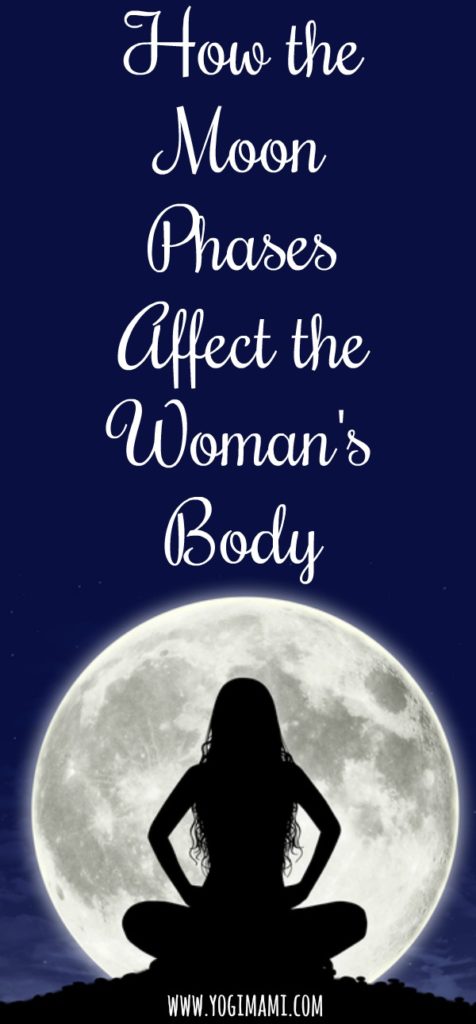
Did you know that the moon phases affect us emotionally, mentally and physically? From tides to different moods, the moon is believed to cause a number of things. This post will share with you how the moon phases affect the woman’s body.
How the Moon Phases Affect the Woman’s Body
Moon Phases and Menstrual Cycles
While most assumptions on how the lunar cycle affects menstruation are speculation, there have been several studies performed to try to find a correlation between the two.
In the 1980s, Winnifred B. Cutler published a study in the American Journal of Obstetrics & Gynecology that studied 312 university women who were menstruating. The study found that 40 percent of participants had the onset of menstruation within two weeks of the full moon, which means they were ovulating during the “dark phase,” or second half of the moon cycle also known as the new moon, when the moon isn’t visible from earth. The study showed that 69 women had a menstrual cycle of about 29.5 days, the same length as the lunar cycle. Dr. Christian Northrup, an OB/GYN, says the phrase “moon time” was used for ages as a euphemism for menstruation, and when women lived together in clans, their menstrual cycles lined up with each other and the moon cycles.
Women have been looking to the sky for cues about their fertility for hundreds of thousands of years, and it’s even believed that the first calendars were created as a result of charting ovulation and menstruation. Since the lunar cycle lasts 29.8 days, it made sense that it would align almost perfectly with women’s menstrual cycles. By tracking your period and your body’s changes throughout the month, you’ll gain a better idea of when to expect your period, and have a clearer understanding of your body’s unique rhythms. It’s simple, just jot down your cycle—when you’re bleeding, when you experience PMS or PMDD symptoms, and then again about 14 days later when you are ovulating—in a good old fashioned journal, calendar, or agenda book. Many online calendars and agendas will already have icons for lunar phases, or you can checkout My Moontime, an excellent smartphone app for tracking your cycle and the moon.
After keeping track of your body’s cycles for a few months, you’ll know whether you tend to menstruate around the new moon—the beginning of the lunar cycle—or the full moon, which is the end of the month’s lunar cycle, or the waxing and waning periods in between. Some believe that periods should align with the new moon, since the dark-moon phase is so closely associated with rest and withdrawal for self-care. However, everyone is unique and there’s no “correct” moon phase to menstruate with.
According to Miranda Grey, author of Red Moon—Understanding and Using the Creative, Sexual and Spiritual Gifts of the Menstrual Cycle, there are two traditional menstruation patterns; “White Moon” bleeding, or menstruating with the new moon and ovulating with the full moon, and “Red Moon” menstruation, which is bleeding with the full moon and becoming fertile with the new moon. Your period will attune to both cycles over the course of your life, but to me it is so fascinating to note what’s going on in your life energetically as your body cycles.
White Moon: If your body follows a White Moon cycle, you’ll tend to bleed during the new or waning moon. Since biodynamics have shown that the earth is most fertile during full moons (when you ovulate), this cycle is most traditionally linked to fertility and motherhood. If you are a “White Moon” woman, you’ll likely feel a surge in your intuition during your period, and will feel the urge to withdraw for nourishment and self-renewal. In other words, you’re tapped out energetically and now it’s time for self-care and “you” time.
Red Moon: This cycle follows the full moon, meaning that your body bleeds during the waxing or full moon and is most fertile during the new or waning moon. Because full and waxing moon phase energies are outgoing, vibrant, and creative, some feel this is counterintuitive to menstruation. This is not the case,In ancient times, the Red Moon cycle was associated with shamanism, high priestesses, and healers. Women who tend to menstruate with the full moon are said to focus their “darker” and more creative menstrual energies outward, rather than inward, in order to nourish and teach others from their own experience. Many times, women with this cycle will be more focused on self-growth, development, mentorship, and creativity.
Moon Phases and Childbirth
The moon’s influence is what is known as the lunar effect. It has long been believed if a woman is full term around the time the moon is full, its gravitational pull can influence when she will go into labor. Just as the moon’s pull affects the waters on earth, it is believed to affect the amniotic fluid in a pregnant woman’s womb. If the amniotic sack is under pressure, it can rupture and contractions might begin. Many midwives, doulas and birth professionals will attest there is an increase in the number of births during the full moon. There are many stories about maternity wards overflowing with laboring women during the full moon phase, but so far there is no scientific evidence to support this phenomenon of the Full Moon causing childbirth. However, recent research found that cow births increase depending on the moon phase. While this doesn’t prove the same for humans the result findings should eventually lead to discoveries that can be generalized to human births.
My Experience
I have been tracking my cycle for the last couple years and have learned so much about myself. I know where I am in my cycle based on the moon phases. I have also learned how the different moon cycles affect me emotionally, mentally and physically. I think it both fascinating and insightful how our body responds to the natural rhythms and can teach us so much about ourselves.

Like what you've read? Sign-up for my newsletter and get tips and other information on how to live a healthier and happier lifestyle!

